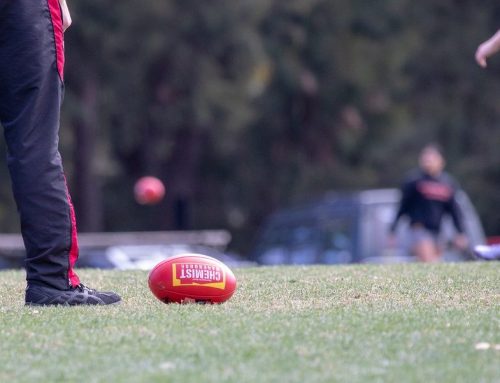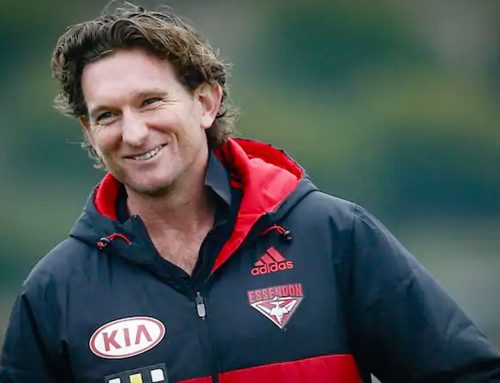I first met James at Essendon Football club where he was a player (AFL) and I was part of the Myotherapy team that treated the players once a week to help with any injuries and also prevent any occurring from tight muscles left untreated.
For two seasons I treated James twice a week both at the club and also once a week at our Toorak clinic. Most of our sessions were very much related to the prevention of all the common football injuries and this seemed to work well.
Growing up in South Africa, football was not a sport I followed very strongly. However, I would often watch Essendon once I worked for them, as I knew the players and that made it more enjoyable for me to see them succeed and be able to talk about it with them the following week. I also watched it a lot to follow any injuries that may have occurred to my list of players that were assigned to me so that I was on top of my game!
I tell you this to paint the picture that I was not aware of James’s facial injury which he sustained in his career (as I never watched football) until it came up in conversation during one of our consultations, when he told me about his tooth pain and how he was going to get his tooth removed as soon as he retired.
It was during this consult that I started to ask more questions about the nature of his pain and duration of the pain etc. I asked him if he had ever had his jaw treated (Temperomandi bular joint, TMJ). I worked out that his tooth pain could have been referred from a trigger point in one of his jaw or facial muscles.
I mentioned to James that I would like to try and work on the muscles directly affecting the tooth he was having problems with and see if it could change the pain. As you can imagine *(read below) the injury was pretty bad and a lot of bones of his face and skull were affected. James agreed to as he was nearing the end of his playing career and so he wanted to try and save his tooth. It was felt that the pain may be coming from one of his teeth and therefore if they removed this tooth, it would take away or change his pain.
You can imagine James’s face when I changed his treatments to incorporate his jaw, where I would put gloves on and I treated his jaw muscles from inside his mouth.
Myotherapy is great in the treatment of jaw pain, which we find is very often overlooked.
After the first treatment he was very happy, as it seemed to really lift his pain, after this I went on to treat his jaw a few times, and each time he reported a definite reduction in his level of discomfort. I also gave James some take home self- massage techniques to do with the jaw.
James decided not to get his tooth taken out as we felt it was not the cause of his pain; it was probably the result of his facial injury, and probably trigger points that developed as a result of the direct impact or possibly as a secondary problem that may have occurred post surgery.
We were both thrilled with this result.
*”Sports medicine expert Dr Peter Larkins said he had never known such a serious facial injury in AFL.”
“He has a compound fracture, which means the bone was exposed to the outside surface,” Larkins said on Channel9. “It’s a five-part fracture incorporating most of the left eye socket but it does go into the forehead. It does go into the nose, it goes into the upper teeth and goes across to the right side of his face.
“His whole middle third of his face got shifted to the right side when he got hit on the left side.
“This is an injury we normally see in motor-car accidents where the middle third of the face gets caved in. It’s a common trauma injury in high-velocity accidents.”
[1]^ “Hird has surgery on facial injuries”. Sydney Morning Herald. 2002-05-02. http://www.smh.com.au/articles/2002/05/05/1019441459678.html
Retrieved 2009-03-22.
From J G Travell and D G Simons,
1983, Myofascial pain and dysfunction.
The trigger point manual.
Williams and Wilkins, Baltimore p 237.
Elite Myotherapy – James Hird Tooth Injury treated by Elite Myotherapy
For your information
A dysfunction in the TMJ (jaw) can cause severe headaches and teeth related issues if left untreated. Many people are unaware they clench or grind their teeth. This is a major cause of TMJ problems. People will tend to grind their teeth at night and clench during daytime hours.
A very interesting fact by (Friedmann, 1995) that illustrates the amount of force that goes through the jaw when grinding is;
The amount of force generated by the jaw muscles when the teeth bite a hard chocolate from the fridge is about 180lb. The force that occurs in the jaw muscles when we grind our teeth is about 5000lb.
Many people grind their teeth every night, some aware of it and others not. Either way it may explain why you may wake up and not feel fresh after a night’s sleep. Some people even report that their teeth ache in the morning. We can see immediate involvement of the jaw by studying your teeth and noting the shape of your face.
At Elite Myotherapy we are trained to know what to look for and what history to take about your condition to work out any jaw involvement. I could go on for hours about how to manage jaw pain or headaches coming from this region, but as every individual is different it is better to come into the clinic and mention to your therapist that you are wanting your jaw to be assessed.
By Samantha RigbyElite Myotherapy – James Hird Tooth Injury treated by Elite Myotherapy
Disclaimer: James has given Elite Myotherapy permission to use his name. At Elite Myotherapy we hold the patient confidentiality policy in high regard. This article is intended to help bring awareness to clients of how pain can often seem to be coming from somewhere when in fact it does not!
Everyone will remember seeing on the news the terrible injury James received to his face when he collided with another player on the football field.






